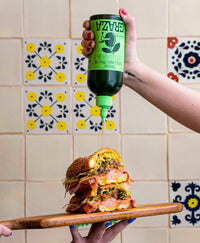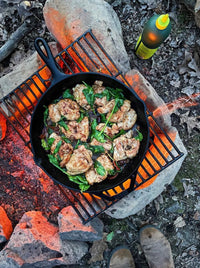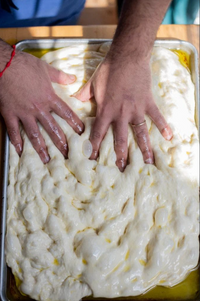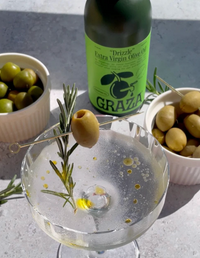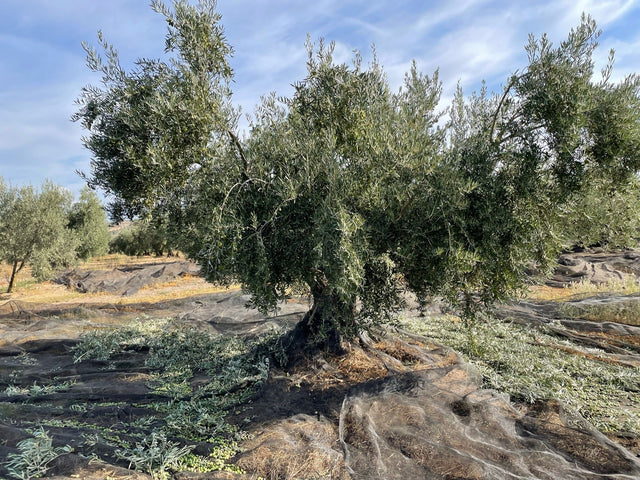
10 Fun Facts About Extra Virgin Olive Oil
![]()
Everything you need to know about nature's delicious love juice
Olive Oil FAQ
Where does the BEST olive oil come from?
The best olive oil is the freshest olive oil, regardless of its origin.
How do you choose the freshest one then? The trick is to figure out how recently the olives were picked.
Go to your kitchen right now, and check out your olive oil. Does it say when it was bottled? Look again. See a “best by” date? If the bottle tells you when the olives were picked, that means you can trust it to be fresh and delicious. That date is called a harvest date, and ideally, you should purchase olive oil within a year of harvest.
That’s because real Extra Virgin Olive Oil is essentially cold-pressed juice that's been separated from the rest of the olive using a specialized mixing process called malaxation. EVOO is technically a raw product, and if full of complex flavor compounds like aldehydes, phenols, and even chlorophyll that begin to change and break down the moment each olive leaves the tree.
Where is the MOST Extra Virgin Olive Oil Coming from?
The most common places for Extra Virgin Olive Oil to be produced are Spain, Greece, France, and Italy.
Italy produces a surprisingly low 15% of the world’s olive oil. Their olive production has recently been threatened by everything from global warming to a deeply inconvenient bacteria by the name of Xylella fastidiosa, limiting the Italian supply and making their oil even more expensive. 100% Extra Virgin Olive Oil from Italy is incredible, but it’s hard to get your hands on these days.
Isn't Graza olive oil from Spain?
Yep! And actually, here’s a fun fact: contrary to popular belief, most of the world’s olive oil is from Spain!
The Spanish supply about 45% of the olive oil industry, but olive farms thrive throughout the Mediterranean in places like Greece, Tunisia, and Morocco. Plus, growing olives has recently become insanely popular in parts of Asia — Japan exported 276.23 metric tons of olive oil in 2019.
Spaniards have been growing olives and making olive oil since Roman times — there are olive farms in Spain with 2,000-year-old trees!. Graza currently sources from a farm in the Sierra de Cazorla mountains in Jaen, Spain. That farm only grows Picual olives (an incredible, hand-harvested variety that rarely leaves Spain).
It doesn’t have any 2,000-year-old trees, but if you’re cool with settling for trees that are 500 years old, we are too. Oh, and if we start selling olive oil from another country, we’ll let you know all about it.
So, what does Extra Virgin mean anyway?
Extra Virgin is just a fancy term for the first pressing — the best-tasting olive oil from any given batch is the first oil that gets made.
But to be certified Extra Virgin, the oil needs to have an “excellent flavor and odor” and undergo testing to ensure it contains precisely what the producer says it does. Graza’s olive oil is certified Extra Virgin in Spain, which means it meets some incred
Are there other kinds of olive oil that I should know about?
Indeed!! In fact, we make one — hi Frizzle!!
Frizzle is our high heat cooking oil made from 100% olives — and is a delicious mix of high-quality olive pomace oil and Extra Virgin Olive Oil. Olive pomace oil is a repress of the paste (or olive pomace) left over from the production of EVOO.
Unlike other olive pomace and seed oils, our olive pomace oil is naturally extracted and refined without any chemicals, additives, or solvents. Instead, we use a little bit of heat and pressure to remove all impurities. Frizzle has a smoke point up to 490ºF, which makes it excellent for frying, grilling or crisping — all the really hot stuff that EVOO can’t handle!ibly exacting standards.
What does good olive oil taste like? How do you know if it’s high quality?
Olive oil can taste grassy or peppery, fruity or buttery, bitter, astringent, or nutty. Sometimes it’s all of those things at once. Really, the list of adjectives could go on and on.
Every variety of olive tastes different, and so does every olive oil. When you’re shopping for a good Extra Virgin Olive Oil, you want one to be complex and layered to brighten and make it, you know, exciting.
That being said, there are instances when you might want the taste of olive oil to take a back seat in your recipe, like in a stir fry, or perhaps a batch of chocolate chip cookies. That’s where Frizzle comes in — our neutral, buttery-smooth, naturally-refined high heat cooking oil (without the strong olive-y taste).
I see words like blended, pure, and light on other olive oil bottles. What do those words mean?
There’s a lot of strict rules when it comes to olive oil. Legally, pure olive oil has to contain 10% Extra Virgin Olive Oil, and light olive oil doesn’t need to contain any Extra Virgin Olive Oil.
Blends, “pure” or “light” olive oil technically don’t meet the standards of EVOO, hence their names. This also means that they don’t necessarily have the same amazing health benefits as EVOO, and will taste a little different.
Is olive oil as healthy as people say it is?
Yes! The hype is real, as they say.
Olive oil is full of monounsaturated fats like oleic acid and antioxidants such as vitamins E and K. All of these are brilliant for reducing inflammation, but olive oil’s nutritional superpowers only start there. Consuming olive oil reduces the risk of heart disease, Alzheimer’s, type 2 diabetes, and early research suggests it might prevent cancer. Some doctors even use olive oil to treat rheumatoid arthritis.
Living longer is important, but do you want to know the best part? Olive oil has an antioxidant in it called oleocanthal, and oleocanthal mimics the effects of pain medication. It’s similar to ibuprofen.
What’s a smoke point? Should I avoid cooking with olive oil?
Ooh, chemistry time.
First off, the smoke point is the temperature at which an oil burns. It starts to taste acrid, and nobody wants that. Luckily, even if you exceed an oil’s smoke point, it’s totally safe to eat unless you’re reusing the oil several times. As long as you’re not operating a fast-food spot, you should be fine.
Our Sizzle cooking smoke point is around 410℉, but Italians have been pouring EVOO on pizzas baked in 900℉ ovens for centuries, so you should technically be good to use it in most instances. If you REALLY wanna crank the heat, go for Frizzle — our high heat cooking oil that can handle up to 490ºF.
Our “Drizzle” oil is special. Because it’s made with young olives, it has lots of delicate flavor compounds in it that are destroyed when it heats up. Honestly, though, Drizzle tastes so good it would be a shame to cook with it. Squeeze some on a summer tomato. You’ll see what we mean.
Can olive oil go bad? How should I store it to avoid that?
Olive oil might seem shelf-stable (and it is), but it can go rancid pretty fast if you store it incorrectly. Why? Because light, heat, and especially oxygen are the enemies of excellent olive oil.
Despite this, most olive oil comes in glass bottles, so you can see what you’re getting. That might look great on a shelf, but even a tinted clear bottle lets light get in, and a cap you have to remove invites oxygen to the party. That’s why Graza’s oil comes in an opaque, squeezable bottle with a cap that you never need to take off.
Got a glass bottle of oil in your pantry? Don’t panic, just store it right, use it up quickly, and you should be fine. Store your olive oil in a cool, dry place far from the stove, bonus points if it’s dark. If you have a cave handy, that would be ideal. Or, you know, a cabinet works too.







